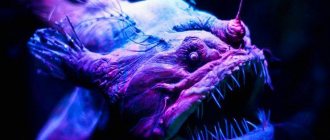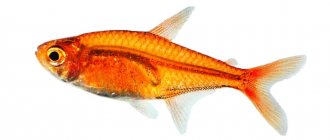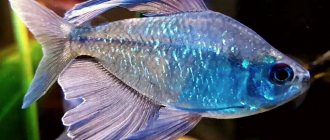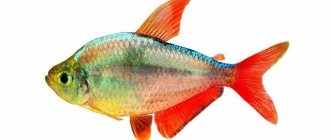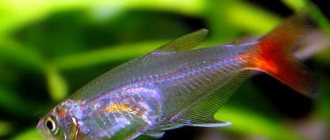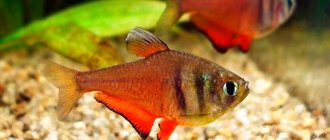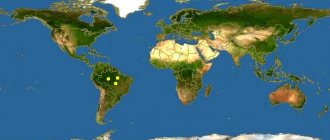Erythrozonus - Hemigrammus erythrozonus
Erythrozonus Hemigrammus erythrozonus Durbin , 1909). The common Russian name is Tetra firefly . Old Russian aquarists also call the fish “Gracilis” (after the outdated Latin name Hyphessobrycon gracilis). Belongs to the order Cypriniformes, suborder Characoidei, family Characinidae, or American tetras (Characidae). Size about 4 cm.
erythrosonus
The habitat of the fish is the north of the South American continent (Guyana, Suriname). Erythrozonus lives in small rivers with a peat bottom, under a dense canopy of trees. Light penetrates the water through dense foliage in very small quantities, giving only twilight. From peat and humic acids formed from rotting falling leaves, the water has a brown color, which further reduces its light transmission. As a result, the fish (being schooling) in order to find each other in semi-darkness have a red stripe along their entire body, which, when exposed to the meager glare of the sun, flashes like a bright neon advertisement. With the exception of this stripe, the rest of the fish’s body is brownish-transparent... The male has a flat, even slightly concave abdomen; the female's abdomen is slightly convex.
A feature of dark reservoirs saturated with humic substances is that the water in them is almost completely devoid of bacteria - that is, practically sterile - and has an acidic active water reaction (pH), of the order of 6.0–6.5. And the almost complete absence of calcium in the peat-leaf bottom gives very low hardness (gH– 1–3, KH– 0–0.1). The difficulty of sunlight illuminating the water for most of the year has led to the fact that the eggs and larvae of this fish tolerate direct light very poorly (they, of course, do not “expose” like photographic film - but close to it)...
erythrosonus
Habitat in nature
The fish was first described in 1909. It lives in South America, in Rio Essequibo, Guyana. The Rio Essequibo is the largest river in Guyana and along its entire length there are many different biotopes. They are most often found in densely jungled tributaries of the river. The water here is typically dark brown with tannins from decaying organic material and is often very acidic as a result.
They live in flocks and feed on insects and their larvae.
Currently, it is impossible to find wild-caught fish for sale. All traded fish are mass-farmed in various parts of the world.
Description
Erythrosonus is one of the small tetras. It grows up to 5 cm in length, and its lifespan in an aquarium is about 3-4 years.
Hemigrammus erythrozonus is silver in color, and a bright iridescent orange-red stripe runs from the snout to the base of the tail, the front of the dorsal fin being the same color as the stripe. Other fins are silver to transparent.
A school of these fish can amaze even the most experienced and avid aquarist. With age, the fish's body color becomes more pronounced and it becomes beautiful.
It is somewhat similar to black neon, especially its luminous stripe, but it is definitely a different type of fish. It is not difficult to distinguish them; black neon has a correspondingly black body, and erythrozonus is translucent.
Diseases
At about 3 weeks of age, the fry begin to show the distinctive red stripe of Erythrosonus. But this period can become dangerous for fish - there is a threat of neon disease. The disease is caused by the sporozoan plistophora. The first manifestations are lightening of the body and the red stripe. As a result, the color may disappear completely. At the same time, the fish lose weight and there is a lack of coordination. Unfortunately, the disease cannot be cured, and sick fish must be removed from the aquarium as quickly as possible. Keeping the aquarium clean, having a filter and aeration will help to avoid illness.
Erythrozonus in the aquarium, due to its activity, liveliness and brightness, gives a lot of positive emotions and charges with its inexhaustible energy. And simple care conditions will allow you to successfully keep your fish, even if you do not yet have serious experience in aquarium keeping.
Return to content
Feeding
H. erythrozonus is omnivorous and feeds on small live, frozen and artificial foods in the aquarium. Feeding them in an aquarium is not difficult; almost all types of food are good. Flakes, granules, live and frozen food, the main thing is that the fish can swallow them. It is better to feed 2 times a day, in small portions, since the fish almost does not eat food that has fallen to the bottom. If some of the food does end up on the bottom (and this can negatively affect the quality of the water), then it would be wise to add a few unpretentious catfish (for example, speckled catfish or panda catfish) to the aquarium.
For keeping Erythrosonus - firefly tetra, compliance with these conditions may be less strict!
It is enough to maintain the pH at 7.0 and gH to 10-12. The fish is schooling, mobile, active when feeding (only the food should be small enough - the fish has a small mouth). Other sized tetras (various neons, other small hifessobricones and chemigrammus) are quite suitable for company; among other soft-water fish with erythrozonus, you can keep small armored corydoras catfish, as well as small American and African carptooths; small barbs...
erythrosonus
But keep in mind that Erythrosonus (like most fish in this area of South America) tolerates some increase in nitrites and nitrates well, but does not tolerate large amounts of fresh water when changing it! It is better to replace in small portions, but more often...
In nature they eat small insects and zooplankton, and in the aquarium they eat both artificial and live food. The main thing is that the food is small in size. Which is due to their small mouth. We recommend taking food from the Tetra MicroFood series for small fish. In our opinion, this is the ideal food for these babies. The food is small and slowly sinks into the water. Due to this, the fish have time to eat everything and fill their bellies to the top.
It would not be amiss to note that when purchasing any dry food, you should first of all pay attention to the date of its manufacture and shelf life, try not to buy food in bulk, and also store the food in a closed state - this will help avoid the development of pathogenic flora in it .
Keeping in an aquarium
Since Erythrosonus is bred commercially in huge quantities, it is highly adaptable and will do well in most aquariums. It looks especially impressive in a densely planted aquarium and can appear lackluster in very spartan conditions.
Since it is better to keep erythrozonus in a school of 6-10 fish, they need an aquarium of 80 liters or more. They are very undemanding to living conditions, the main thing is that the conditions are reasonable and without extremes. They do best in soft and acidic water, but fish sold in your area are usually already adapted to life in the local water.
Water parameters for keeping: temperature 23-28 °C, pH: 5.8-7.5, 2 - 15 dGH. The most important parameter is the purity of the water and the low content of ammonia and nitrates. To do this, you need to change part of the water weekly (up to 30%) and use a filter in the aquarium.
If you really want to see the fish at its best, it is advisable to create a natural biotope in the aquarium. Use a river sand substrate and add some driftwood (common beech is safe to use as long as it is thoroughly dried and stripped of bark) and twisted roots. A few handfuls of dried leaves (again, beech or oak leaves can be used) will complete the natural feel. Allow the wood and leaves to turn the water the color of weak tea by removing old leaves and replacing them every few weeks to prevent them from rotting and contaminating the water. A small mesh bag filled with aquarium-safe peat can be added to the filter to help simulate blackwater conditions. Use fairly dim lighting. There are not many plants in the rivers where Erythrosonus lives, so it does not need lush thickets. Under these conditions, the true beauty of the fish will be revealed.
The light for keeping any tetras should be diffused and dim; erythrozonus is no exception. The easiest way to achieve this is by placing floating plants on the surface of the aquarium.
Breeding Erythrozonus tetra fireflies at home is quite possible!
Although it is associated with some difficulties associated with the above living conditions). To prepare the spawners for spawning, it is advisable to place the male and female in specially prepared nurseries for 4-5 days and feed them there with small bloodworms or (which is better) with small red daphnia. The easiest way to use water for the spawning tank is rain water, boiled with a small amount of peat (to get gH=0–1, KH= 0–0.1, pH=6). Leave some of the water in reserve (later it will be clear why)... Instead of peat, you can use the drug “Ichthyovit Akvagumat” - but it is better to add it twice - before and after boiling... Even a three-liter jar with a light blowing in it can be a spawning ground. The jar must first be washed with hot water and the prepared water must be poured into it. Place a bush of ARTIFICIAL plants, scalded with boiling water, into a jar and cover with something to prevent dust from getting in. Next, you need to tightly wrap the jar with 2-3 layers of newspaper (to protect from light) and secure the newspaper to the jar with an elastic band. You need to put some kind of weak lighting device behind (but so that the light does not come from above!) Do not turn off the light at night! In front, you need to use a blade to cut out an inverted letter “P” on the newspaper below. Thus, by lifting this “P”, it will be possible to surreptitiously observe the process...
So, before planting the fish, the jar should stand with a sprayer for 3-4 days (at t 24-25). Then you need to catch a pair (male and female) of erythrozonus, ready for spawning, and put them in some TEMPORARY small vessel with a very small amount of water from the aquarium where they lived. And then, in small portions, add water prepared in reserve (that’s what it was needed for), identical to the water in the spawning tank. These small portions must be added once every 5 minutes for at least half an hour in order to adapt the fish to the spawning water. It is better to do this around 5–6 pm. Then you can transplant the spawners into the spawning tank (pre-scald the net) and close the jar again. If the producers are well prepared, spawning can occur even this night or in the morning. You can follow him. During spawning, the fish press tightly against each other, rise above the plants to the surface of the water, there they do somersaults and swim upside down, throwing out a portion of caviar and milk. It lasts 2–3 hours.
erythrosonus
In total, 80–100 eggs are spawned. After spawning, the fish need to be landed (with a newly scalded net) and the jar closed again. Light (through the newspaper) should be on around the clock. After about a day, the larvae will begin to hatch. In another 2-3 days they will swim - and you can start feeding them (ciliates or - if there are none - rubbing a VERY SMALL amount of Sulfur Micron food in water). After another three days you can put away the newspaper. Only replace water with what was stored in reserve. After two weeks, you can turn off the lights at night and treat the fry as you would any characin fry. After a month, you need to start replacing the water with the one in which you will keep the fry under normal conditions...
The fry grow quickly. By the age of one month, they already have a red stripe. They ripen after six months.
tetra firefly
All of the above is just the fruit of observing this type of aquarium fish and collecting various information from owners and breeders. We would like to share with visitors not only information, but also live emotions that allow us to understand the world of aquariums more fully and subtly. Register at https://fanfishka.ru/forum/ , participate in discussions on the forum, create profile topics where you will talk about your pets in the first person and first-hand, describe their habits, behavioral features and content, and share with us your successes and joys, share your experiences and learn from the experiences of others. We are interested in every bit of your experience, every second of your joy, every awareness of a mistake, which makes it possible for your comrades to avoid the same mistake. The more of us there are, the more pure and transparent drops of goodness there are in the life and everyday life of our seven billion society.
FanFishka.ru thanks the author V.M. Chernyavsky
for cooperation and provided material.
Compatibility
They look very good in a community aquarium, with small and peaceful fish. This characin is one of the most peaceful aquarium fish. Like other tetras, Erythrosonus feels good only in a flock of 6-10 individuals and above. They tend to swim in denser schools when a potential predator is present, and swim freely when they are comfortable and safe.
They are often purchased by aquarium owners to play the role of “second fiddle” in a flock of neons. Although they usually swim separately from the common neons and red neons, sometimes they will swim alongside them, creating a spectacular sight...
In general, Erythrozonus is compatible with any small, non-predatory fish. He doesn't bother anyone, not even small fish like Endler's guppies. But he himself can become a victim of large fish, such as American cichlids (diamond cichlid, black-striped cichlid, angelfish) or catfish (Clarias, sacbranch catfish, pangasius).
Characteristics of aquarium fish
Erythrozonus are one of the most popular fish used in home aquarium keeping.
Appearance and habitat
Tetra is a South American river fish, adults of which reach a length of 4 cm and a weight of 1 g. A distinctive feature of this species is the bright coral-red stripe that runs along the entire length of the body from the head to the caudal fin.
The older the fish, the brighter its color will be. Another characteristic sign of a tetra is a red outline above the eye and a blue flickering spot below it. The body of these fish is flattened, almost transparent, the scales have a greenish metallic tint.
Learn more about the types of tetras and how to care for these fish.
The tetra's fins are red at the base, and become milky white closer to the tips. There are dorsal, anal and adipose fins. Under natural conditions, erythrozonus live in shallow, warm, fast-flowing rivers.
Video: keeping erythrozonus in an aquarium They prefer sandy bottom areas overgrown with dense vegetation, where these fish live, find food, and also incubate eggs.
Important! Tetra fry are particularly small in size, so they must be heavily fed with ciliates and rotifers in the first week and a half of life. At an early age, even their parents pose a threat to them, who often eat only the hatched fry.
Sex differences
Erythrozonus females are noticeably larger than males - they have a wider back and a more rounded abdomen. Males, on the contrary, are small in size and have a thin, narrow body. In males, the snow-white spots on the fins are more pronounced. The abdomen of males becomes lighter in color as they mature.
